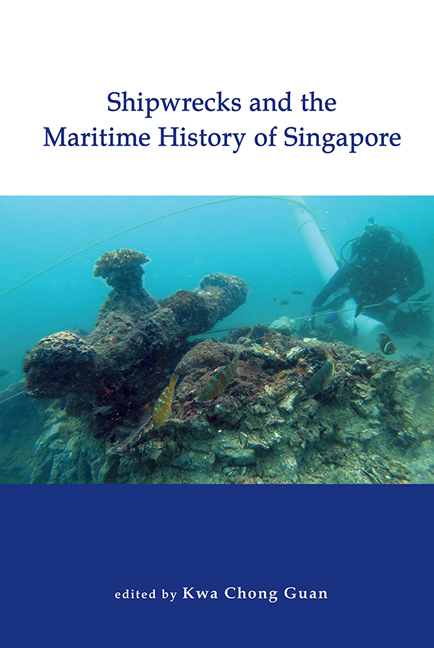Book contents
- Frontmatter
- Contents
- Foreword
- Acknowledgements
- Contributors
- 1 Introduction: Two Historical Shipwrecks and Their Implications for Singapore History
- 2 The Temasek Wreck
- 3 The International History of Temasek: Possibilities for Research Emerging from the Discovery of the Temasek Wreck
- 4 Singapore’s Waterways before the Modern Era
- 5 A Seventeenth-Century Port Settlement in the Kallang Estuary
- 6 The Shah Muncher
- 7 Singapore and the Country Trade in the Late Eighteenth and Early Nineteenth Centuries
- Index
6 - The Shah Muncher
Published online by Cambridge University Press: 01 March 2024
- Frontmatter
- Contents
- Foreword
- Acknowledgements
- Contributors
- 1 Introduction: Two Historical Shipwrecks and Their Implications for Singapore History
- 2 The Temasek Wreck
- 3 The International History of Temasek: Possibilities for Research Emerging from the Discovery of the Temasek Wreck
- 4 Singapore’s Waterways before the Modern Era
- 5 A Seventeenth-Century Port Settlement in the Kallang Estuary
- 6 The Shah Muncher
- 7 Singapore and the Country Trade in the Late Eighteenth and Early Nineteenth Centuries
- Index
Summary
While excavating the fourteenth-century Temasek Wreck off Pedra Branca,1 tidal overfalls were frequently observed, waves broke on submerged rocks, and intense squalls struck out of nowhere. All this during neap tides in the calm season. The wrecking potential of the rock outcrop at the eastern entrance of the Singapore Strait was very apparent.
In 1596, the Dutch merchant Jan Huygen van Linschoten wrote:
From the Cape of Singapura to the hooke named Sinosura to the east, are 18 miles, 6 or 7 miles from thence lyeth a cliffe in ye sea called Pedra bianque, or White Rock, where the shippes that come and goe from China doe oftentymes passe in great danger and some are left upon it…
Not just some. In Charles Buckley's 1902 work, An Anecdotal History of Singapore, he states:
Between 1824 and 1851, sixteen large vessels were totally lost there [on Pedra Branca] and two others were stranded, besides other minor accidents.
Cursory examination of eighteenth-century records and nineteenthcentury newspapers revealed the names of several of the ships “lost on Pedra Branca”.
With a list of possible shipwrecks, and the potential discovery of more pre-European sites such as the Temasek Wreck, which were not recorded in state or company archives, the National Heritage Board (NHB) commissioned the Archaeology Unit (AU) of the ISEAS – Yusof Ishak Institute to carry out a search in the immediate vicinity of Pedra Branca. The rocky seabed precluded side-scan or multibeam sonar, so a magnetometer was deployed to detect cannons, anchors, iron cargoes or any other ferrous objects that could be associated with shipwrecks.
The search was conducted in mid-2019. After several fruitless dives on magnetometer hits, it was frustrating to discover that geomagnetic rock outcrops were causing the anomalies. But one anomaly was so big that it could only have been caused by a large quantity of iron. This turned out to be the twisted steel hull and cargo of the MV Yu Seung Ho, which had struck rocks and sank some three hundred metres east of Horsburgh Lighthouse in 1979.
- Type
- Chapter
- Information
- Shipwrecks and the Maritime History of Singapore , pp. 80 - 100Publisher: ISEAS–Yusof Ishak InstitutePrint publication year: 2023



